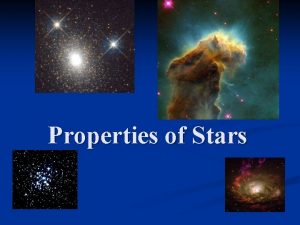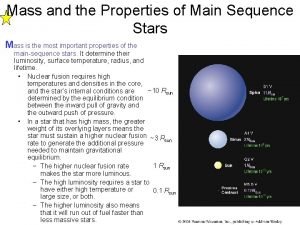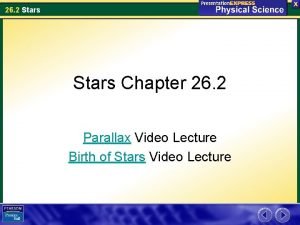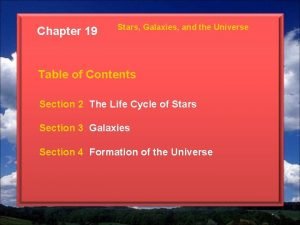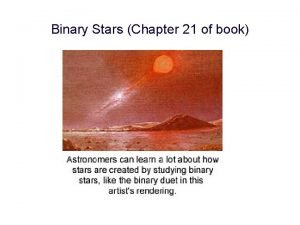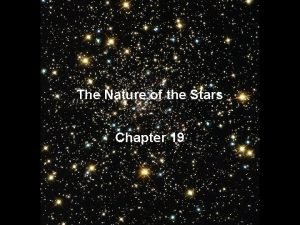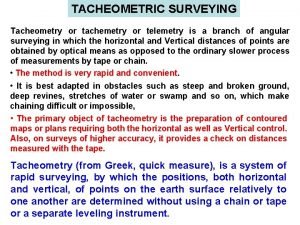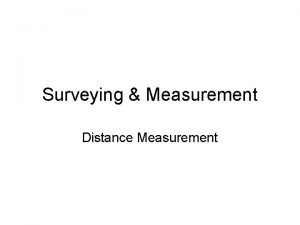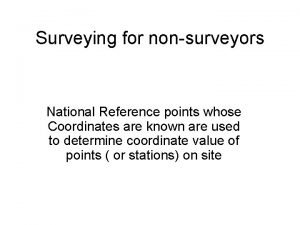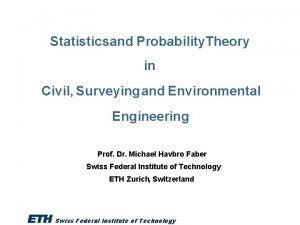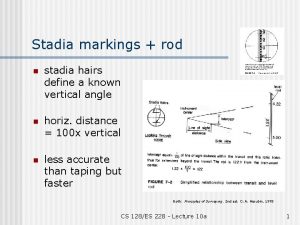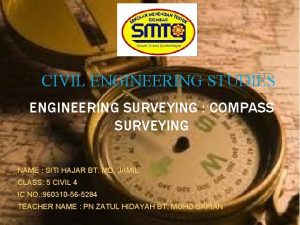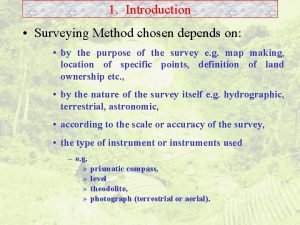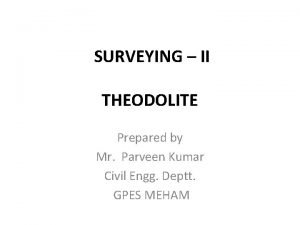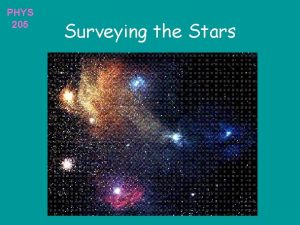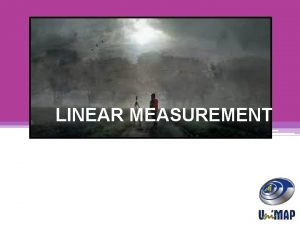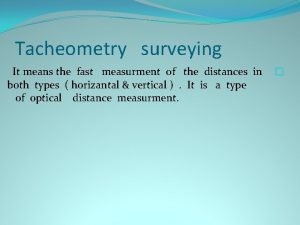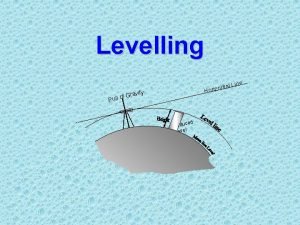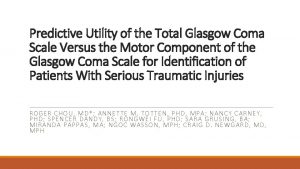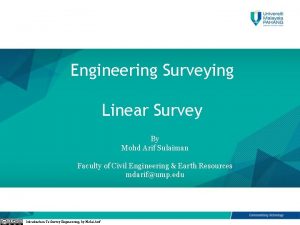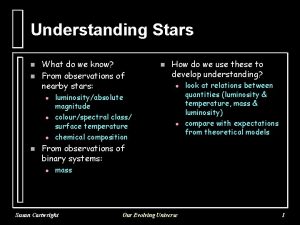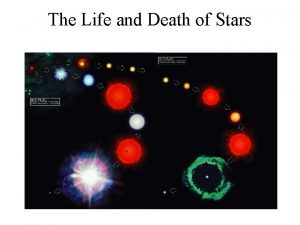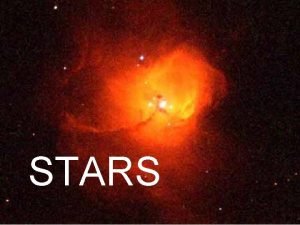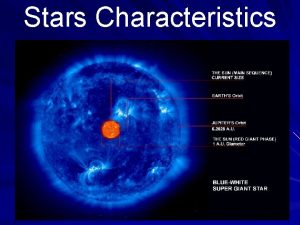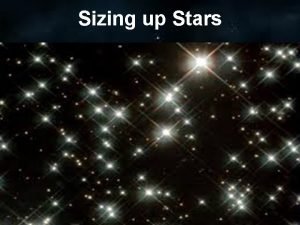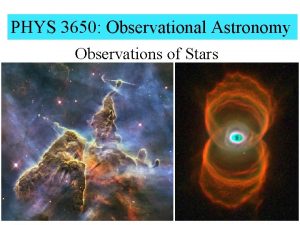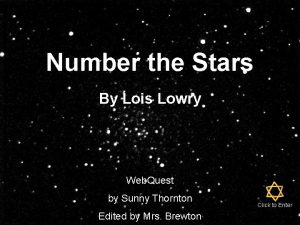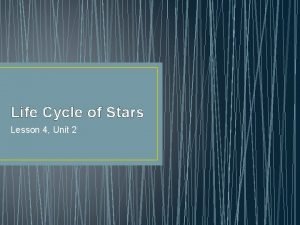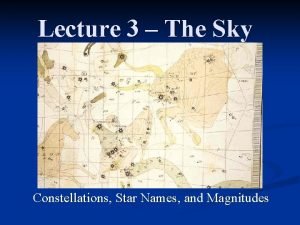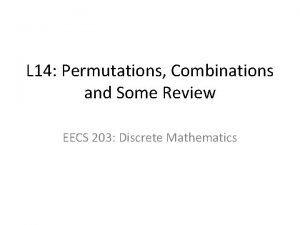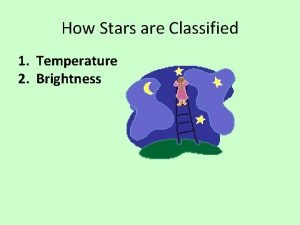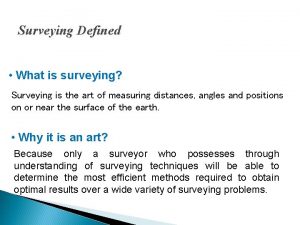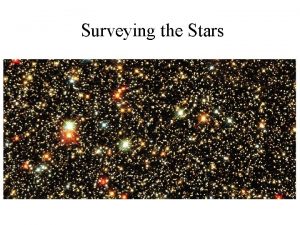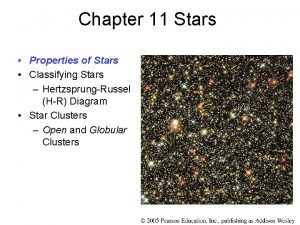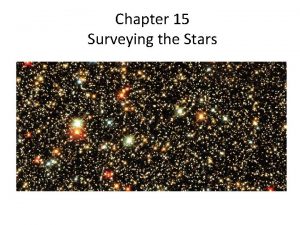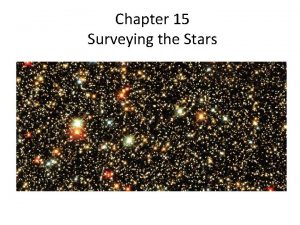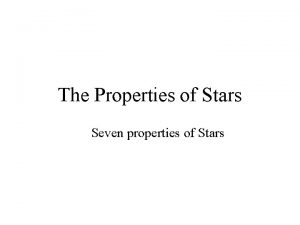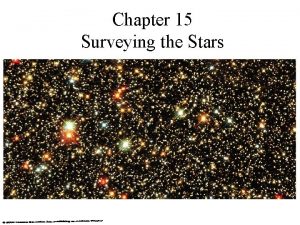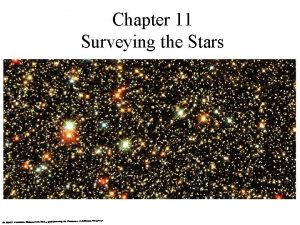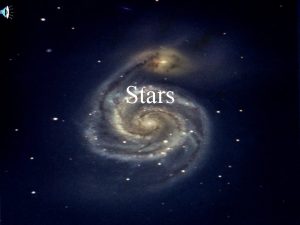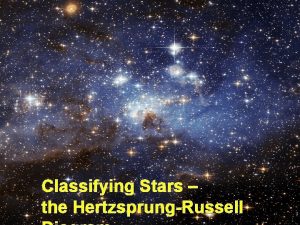Chapter 11 Surveying the Stars 11 1 Properties























































































































































- Slides: 151

Chapter 11 Surveying the Stars

11. 1 Properties of Stars Our goals for learning: • How do we measure stellar luminosities? • How do we measure stellar temperatures? • How do we measure stellar masses?

How do we measure stellar luminosities? And why do we care? Let’s say we want to find out how far away a star is… We can’t measure the distance directly But we can easily measure the brightness And brightness is related to distance and luminosity

Luminosity and distance are not so easy.

Luminosity and distance are not so easy. However…

if we can relate brightness, luminosity, and distance…

we can calculate any of them if we know the other two.

This is very important and useful.

This is very important and useful. But first…

What is luminosity?

Luminosity: Amount of power a star radiates (joules/sec = watts)

Luminosity: Amount of power a star radiates (joules/sec = watts) Example: A 100 W light bulb has a luminosity of 100 W

Luminosity: Amount of power a star radiates (joules/sec = watts) This is different from brightness:

Luminosity: Amount of power a star radiates (joules/sec = watts) This is different from brightness: Amount of starlight that reaches Earth (watts/square meter)

Thought Question These two stars have about the same luminosity — which one appears brighter? A. Alpha Centauri B. The Sun

Thought Question These two stars have about the same luminosity— which one appears brighter? A. Alpha Centauri B. The Sun

How are luminosity and brightness related?

How are luminosity and brightness related? • Luminosity passing through each sphere is the same

How are luminosity and brightness related? • Luminosity passing through each sphere is the same • But the area increases

How are luminosity and brightness related? • Luminosity passing through each sphere is the same • But the area increases • Area of sphere = 4πR 2

How are luminosity and brightness related? • Luminosity passing through each sphere is the same • But the area increases • Area of sphere = 4πR 2 • Divide luminosity by area to get apparent brightness.

The Inverse Square Law for Light The relationship between apparent brightness and luminosity depends on distance:

Thought Question How would the apparent brightness of Alpha Centauri change if it were three times farther away? A. B. C. D. It would be only 1/3 as bright. It would be only 1/6 as bright. It would be only 1/9 as bright. It would be three times as bright.

Thought Question How would the apparent brightness of Alpha Centauri change if it were three times farther away? A. B. C. D. It would be only 1/3 as bright. It would be only 1/6 as bright. It would be only 1/9 as bright. It would be three times as bright.

Thought Question How would the apparent brightness of Alpha Centauri change if it were three times farther away? A. It would be only 1/3 as bright. B. It would be only 1/6 as bright. C. It would be only 1/9 as bright. D. It would be three times as bright.

The relationship between apparent brightness and luminosity depends on distance: Measuring brightness is easy, so if we know how far away a star is, we can calculate its luminosity:

The relationship between apparent brightness and luminosity depends on distance: Measuring brightness is easy, so if we know how far away a star is, we can calculate its luminosity:

The relationship between apparent brightness and luminosity depends on distance: Measuring brightness is easy, so if we know how far away a star is, we can calculate its luminosity: Or if we know its luminosity, we can calculate its distance:

The relationship between apparent brightness and luminosity depends on distance: Measuring brightness is easy, so if we know how far away a star is, we can calculate its luminosity: Or if we know its luminosity, we can calculate its distance:

So how far away are these stars?

Parallax is the apparent shift in position of a nearby object against a background of more distant objects. Introduction to Parallax

• Apparent positions of the nearest stars shift by only about an arcsecond as Earth orbits the Sun, and the shift is smaller for more distant stars. Parallax of a Nearby Star

• Apparent positions of the nearest stars shift by only about an arcsecond as Earth orbits the Sun, and the shift is smaller for more distant stars. • These very small angles explain why the Greeks were unable to detect parallax with their naked eyes. Parallax of a Nearby Star

Parallax of a Nearby Star • Apparent positions of the nearest stars shift by only about an arcsecond as Earth orbits the Sun, and the shift is smaller for more distant stars. • These very small angles explain why the Greeks were unable to detect parallax with their naked eyes. • This inability helped delay the acceptance of the geocentric universe for more than 1500 years.

The parallax angle depends on distance. Parallax Angle as a Function of Distance

Parallax is measured by comparing snapshots taken at different times and measuring the angular size of the star’s shift in position. Measuring Parallax Angle

Parallax is measured by comparing snapshots taken at different times and measuring the angular size of the star’s shift in position. Measuring Parallax Angle


This is a right triangle

That means we can use trigonometry


For small angles: sinp ≈ p

So for small angles:

If you express p in arcseconds and d in parsecs…

Parallax and Distance

The apparent brightness of stars varies over a wide range

And there is also a wide range of luminosity

Range of luminosities Most luminous stars: 106 LSun (LSun is luminosity of Sun)

Range of luminosities Most luminous stars: 106 LSun Least luminous stars: 10− 4 LSun (LSun is luminosity of Sun)

Range of luminosities This is a wide range

Range of luminosities This is a wide range To compress it, the magnitude scale was devised, originally by the Greeks

Range of luminosities The Greeks assigned stars six magnitudes numbered from 1 to 6

Range of luminosities The brightest stars had a magnitude of 1 and the dimmest had a magnitude of 6

Range of luminosities The magnitudes in between differed from each other by about a factor of two

Range of luminosities The modern magnitude scale is based on a magnitude 1 star being 100 times brighter than a magnitude 6 star, so magnitudes differ in brightness by about a factor of 2. 5

The Magnitude Scale

End 14 April 2008 Lecture

11. 1 Properties of Stars Our goals for learning: • How do we measure stellar luminosities? • How do we measure stellar temperatures? • How do we measure stellar masses?

How do we measure stellar temperatures?

Every object emits thermal radiation with a spectrum that depends on its temperature.

• An object of fixed size grows more luminous as its temperature rises. Relationship Between Temperature and Luminosity

• An object of fixed size grows more luminous as its temperature rises. • The color of the light also changes Relationship Between Temperature and Luminosity

Properties of Thermal Radiation 1. Hotter objects emit more light per unit area at all frequencies. 2. Hotter objects emit photons with a higher average energy.

Properties of Thermal Radiation The surface temperature of an object can be determined from the peak of its thermal radiation curve using Wien’s Law:

Hottest stars: 50, 000 K Coolest stars: 3, 000 K (Sun’s surface is 5, 800 K)

106 K 105 K 104 K Ionized Gas (Plasma) 103 K Neutral Gas 102 K Molecules 10 K Solid Level of ionization also reveals a star’s temperature.

Absorption lines in a star’s spectrum tell us its ionization level.

Lines in a star’s spectrum correspond to a spectral type that reveals its temperature: (Hottest) O B A F G K M (Coolest)

Remembering Spectral Types (Hottest) O B A F G K M • Oh, Be A Fine Girl/Guy, Kiss Me (Coolest)

Thought Question Which of the stars below is hottest? A. B. C. D. M star F star A star K star

Thought Question Which of the stars below is hottest? A. B. C. D. M star F star A star K star

Pioneers of Stellar Classification • Annie Jump Cannon and the “calculators” at Harvard laid the foundation of modern stellar classification.

How do we measure stellar masses?

Orbit of a binary star system depends on strength of gravity

Types of Binary Star Systems • Visual binary • Eclipsing binary • Spectroscopic binary About half of all stars are in binary systems.

Visual Binary We can directly observe the orbital motions of these stars.

Eclipsing Binary We can measure periodic eclipses. Exploring the Light Curve of an Eclipsing Binary Star System

Spectroscopic Binary We determine the orbit by measuring Doppler shifts.

We measure mass using gravity. Direct mass measurements are possible only for stars in binary star systems. p 2 = 4π2 G (M 1 + M 2) p = period a 3 a = average separation Isaac Newton

Need both p and a to determine mass 1. Orbital period (p) 2. Orbital separation (a or r = radius) 3. Orbital velocity (v) For circular orbits, v = 2 pr / p r v M

Most massive stars: 100 MSun Least massive stars: 0. 08 MSun (MSun is the mass of the Sun. )

What have we learned? • How do we measure stellar luminosities? —If we measure a star’s apparent brightness and distance, we can compute its luminosity with the inverse square law for light. —Parallax tells us distances to the nearest stars. • How do we measure stellar temperatures? —A star’s color and spectral type both reflect its temperature.

What have we learned? • How do we measure stellar masses? —Newton’s version of Kepler’s third law tells us the total mass of a binary system, if we can measure the orbital period (p) and average orbital separation of the system (a).

11. 2 Patterns Among Stars Our goals for learning: • What is a Hertzsprung–Russell diagram? • What is the significance of the main sequence? • What are giants, supergiants, and white dwarfs?

What is a Hertzsprung– Russell diagram?

Luminosity An H-R diagram plots the luminosities and temperatures of stars. Temperature

Generating an H-R Diagram

Most stars fall somewhere on the main sequence of the H-R diagram.

Large radius • Stars with lower T than main-sequence stars with the same L, or with higher L than main-sequence stars with the same T, must have larger radii

Large radius • Stars with lower T than main-sequence stars with the same L, or with higher L than main-sequence stars with the same T, must have larger radii • This is because more of the cooler surface is required to give the same luminosity as a hotter star

Large radius • Stars with lower T than main-sequence stars with the same L, or with higher L than main-sequence stars with the same T, must have larger radii • This is because more of the cooler surface is required to give the same luminosity as a hotter star • These are giants and supergiants

• Stars with higher T than main-sequence stars with the same L, or with lower L than main-sequence stars with the same T, must have smaller radii Small radius

• Stars with higher T than main-sequence stars with the same L, or with lower L than main-sequence stars with the same T, must have smaller radii • These are white dwarfs Small radius

A star’s full classification includes spectral type and luminosity class

A star’s full classification includes spectral type (based on spectral line identities) and luminosity class

Lines in a star’s spectrum correspond to a spectral type that reveals its temperature: (Hottest) O B A F G K M (Coolest)

A star’s full classification includes spectral type (based on spectral line identities) and luminosity class (based on spectral line shapes, which are related to the size of the star)

“Pressure Broadening” is the basis of luminosity classification increasing size, decreasing pressure Source: http: //spiff. rit. edu/classes/phys 440/lectures/lumclass. html

“Pressure Broadening” is the basis of luminosity classification increasing size, decreasing pressure Why do you think increasing the size would decrease the pressure at the surface of the star? Source: http: //spiff. rit. edu/classes/phys 440/lectures/lumclass. html

A star’s full classification includes spectral type (line identities) and luminosity class (line shapes, related to the size of the star): I — supergiant II — bright giant III — giant IV — subgiant V — main sequence Examples: Sun — G 2 V Sirius — A 1 V Proxima Centauri — M 5. 5 V Betelgeuse — M 2 I

H-R diagram depicts: Temperature Luminosity Color Spectral type Luminosity Radius Temperature

C Luminosity B Which star is the hottest? D A Temperature

C Luminosity B Which star is the hottest? D A A Temperature

C Luminosity B Which star is the most luminous? D A Temperature

C Luminosity B Which star is the most luminous? C D A Temperature

C Luminosity B Which star is a main-sequence star? D A Temperature

C Luminosity B Which star is a main-sequence star? D D A Temperature

C Luminosity B Which star has the largest radius? D A Temperature

C Luminosity B Which star has the largest radius? C D A Temperature

What is the significance of the main sequence?

Main-sequence stars are fusing hydrogen into helium in their cores, like the Sun. Luminous mainsequence stars are hot (blue). Less luminous ones are cooler (yellow or red).

High-mass stars Low-mass stars Mass measurements of main-sequence stars show that the hot, blue stars are much more massive than the cool, red ones.

High-mass stars Low-mass stars The mass of a normal, hydrogenburning mainsequence star determines its luminosity and spectral type!

High-mass stars Low-mass stars The mass of a normal, hydrogenburning mainsequence star determines its luminosity and spectral type! The reason is gravitational equilibrium, also called hydrostatic pressure

The core pressure and temperature of a higher-mass star need to be higher in order to balance gravity. A higher core temperature boosts the fusion rate, leading to greater luminosity. Hydrostatic Equilibrium

Stellar Properties Review Luminosity: from brightness and distance 10− 4 LSun– 106 LSun Temperature: from color and spectral type 3, 000 K– 50, 000 K Mass: from period (p) and average separation (a) of binary-star orbit 0. 08 MSun– 100 MSun

Stellar Properties Review Luminosity: from brightness and distance (0. 08 MSun) 10− 4 LSun– 106 LSun (100 MSun) Temperature: from color and spectral type (0. 08 MSun) 3, 000 K– 50, 000 K (100 MSun) Mass: from period (p) and average separation (a) of binary-star orbit 0. 08 MSun– 100 MSun

Mass and Lifetime Sun’s life expectancy until core hydrogen (10% of total) is used up: ~10 billion years

Mass and Lifetime Sun’s life expectancy until core hydrogen (10% of total) is used up: ~10 billion years Life expectancy of a 10 MSun star:

Mass and Lifetime Sun’s life expectancy until core hydrogen (10% of total) is used up: ~10 billion years Life expectancy of a 10 MSun star: 10 times as much fuel, uses it 104 times as fast:

Mass and Lifetime Sun’s life expectancy until core hydrogen (10% of total) is used up: ~10 billion years Life expectancy of a 10 MSun star: 10 times as much fuel, uses it 104 times as fast: ~10 million years

Mass and Lifetime Sun’s life expectancy until core hydrogen (10% of total) is used up: ~10 billion years Life expectancy of a 10 MSun star: 10 times as much fuel, uses it 104 times as fast: ~10 million years Life expectancy of a 0. 1 MSun star:

Mass and Lifetime Sun’s life expectancy until core hydrogen (10% of total) is used up: ~10 billion years Life expectancy of a 10 MSun star: 10 times as much fuel, uses it 104 times as fast: ~10 million years Life expectancy of a 0. 1 MSun star: 0. 1 times as much fuel, uses it 0. 01 times as fast:

Mass and Lifetime Sun’s life expectancy until core hydrogen (10% of total) is used up: ~10 billion years Life expectancy of a 10 MSun star: 10 times as much fuel, uses it 104 times as fast: ~10 million years Life expectancy of a 0. 1 MSun star: 0. 1 times as much fuel, uses it 0. 01 times as fast: ~100 billion years

Main-Sequence Star Summary High-mass: High luminosity Short-lived Large radius Blue Low-mass: Low luminosity Long-lived Small radius Red

What are giants, supergiants, and white dwarfs?

Off the Main Sequence • Stellar properties depend on both mass and age: those that have finished fusing H to He in their cores are no longer on the main sequence.

Off the Main Sequence • Stellar properties depend on both mass and age: those that have finished fusing H to He in their cores are no longer on the main sequence. • All stars become larger and redder after exhausting their core hydrogen: giants and supergiants.

Off the Main Sequence • Stellar properties depend on both mass and age: those that have finished fusing H to He in their cores are no longer on the main sequence. • All stars become larger and redder after exhausting their core hydrogen: giants and supergiants. • Most stars end up small and white after fusion has ceased: white dwarfs.

Relationship between Main-Sequence Stellar Masses and Location on H-R Diagram

Main-sequence stars (to scale) Giants, supergiants, white dwarfs

A Which star is most like our Sun? Luminosity D B C Temperature

A Which star is most like our Sun? Luminosity D B C Temperature B

A Luminosity D B C Temperature Which of these stars will have changed the least 10 billion years from now?

A Luminosity D B C C Temperature Which of these stars will have changed the least 10 billion years from now?

A Luminosity D B C Temperature Which of these stars can be no more than 10 million years old?

A Luminosity D A B C Temperature Which of these stars can be no more than 10 million years old?

What have we learned? • What is a Hertzsprung–Russell diagram? — An H-R diagram plots the stellar luminosity of stars versus surface temperature (or color or spectral type). • What is the significance of the main sequence? — Normal stars that fuse H to He in their cores fall on the main sequence of an H-R diagram. — A star’s mass determines its position along the main sequence (high mass: luminous and blue; low mass: faint and red).

What have we learned? • What are giants, supergiants, and white dwarfs? — All stars become larger and redder after core hydrogen burning is exhausted: giants and supergiants. — Most stars end up as tiny white dwarfs after fusion has ceased.


11. 3 Star Clusters Our goals for learning: • What are the two types of star clusters? • How do we measure the age of a star cluster?

What are the two types of star clusters?

Open cluster: A few thousand loosely packed stars

Globular cluster: Up to a million or more stars in a dense ball bound together by gravity

How do we measure the age of a star cluster?

Massive blue stars die first, followed by white, yellow, orange, and red stars. Visual Representation of a Star Cluster Evolving

Main-sequence turnoff Pleiades now has no stars with life expectancy less than around 100 million years.

The mainsequence turnoff point of a cluster tells us its age.

To determine accurate ages, we compare models of stellar evolution to the cluster data. Using the H-R Diagram to Determine the Age of a Star Cluster

Detailed modeling of the oldest globular clusters reveals that they are about 13 billion years old.

What have we learned? • What are the two types of star clusters? — Open clusters are loosely packed and contain up to a few thousand stars. — Globular clusters are densely packed and contain hundreds of thousands of stars. • How do we measure the age of a star cluster? — A star cluster’s age roughly equals the life expectancy of its most massive stars still on the main sequence.
 There are millions of stars in the space
There are millions of stars in the space Classify stars
Classify stars Properties of main sequence stars
Properties of main sequence stars Chapter 3 surveying the books of the bible
Chapter 3 surveying the books of the bible What promise did ellen make to annemarie?
What promise did ellen make to annemarie? Between the stars chapter 26
Between the stars chapter 26 Why isn't kirsti afraid of the soldiers
Why isn't kirsti afraid of the soldiers Chapter 19 section 2 the life cycle of stars answer key
Chapter 19 section 2 the life cycle of stars answer key The stars and i chapter 21
The stars and i chapter 21 The stars and i chapter 19
The stars and i chapter 19 Intensive property and extensive properties
Intensive property and extensive properties Chemical properties of citric acid
Chemical properties of citric acid Hát kết hợp bộ gõ cơ thể
Hát kết hợp bộ gõ cơ thể Lp html
Lp html Bổ thể
Bổ thể Tỉ lệ cơ thể trẻ em
Tỉ lệ cơ thể trẻ em Voi kéo gỗ như thế nào
Voi kéo gỗ như thế nào Glasgow thang điểm
Glasgow thang điểm Hát lên người ơi
Hát lên người ơi Các môn thể thao bắt đầu bằng tiếng đua
Các môn thể thao bắt đầu bằng tiếng đua Thế nào là hệ số cao nhất
Thế nào là hệ số cao nhất Các châu lục và đại dương trên thế giới
Các châu lục và đại dương trên thế giới Cong thức tính động năng
Cong thức tính động năng Trời xanh đây là của chúng ta thể thơ
Trời xanh đây là của chúng ta thể thơ Mật thư tọa độ 5x5
Mật thư tọa độ 5x5 Làm thế nào để 102-1=99
Làm thế nào để 102-1=99 Phản ứng thế ankan
Phản ứng thế ankan Các châu lục và đại dương trên thế giới
Các châu lục và đại dương trên thế giới Thơ thất ngôn tứ tuyệt đường luật
Thơ thất ngôn tứ tuyệt đường luật Quá trình desamine hóa có thể tạo ra
Quá trình desamine hóa có thể tạo ra Một số thể thơ truyền thống
Một số thể thơ truyền thống Cái miệng nó xinh thế
Cái miệng nó xinh thế Vẽ hình chiếu vuông góc của vật thể sau
Vẽ hình chiếu vuông góc của vật thể sau Biện pháp chống mỏi cơ
Biện pháp chống mỏi cơ đặc điểm cơ thể của người tối cổ
đặc điểm cơ thể của người tối cổ Thứ tự các dấu thăng giáng ở hóa biểu
Thứ tự các dấu thăng giáng ở hóa biểu Vẽ hình chiếu đứng bằng cạnh của vật thể
Vẽ hình chiếu đứng bằng cạnh của vật thể Fecboak
Fecboak Thẻ vin
Thẻ vin đại từ thay thế
đại từ thay thế điện thế nghỉ
điện thế nghỉ Tư thế ngồi viết
Tư thế ngồi viết Diễn thế sinh thái là
Diễn thế sinh thái là Dot
Dot So nguyen to
So nguyen to Tư thế ngồi viết
Tư thế ngồi viết Lời thề hippocrates
Lời thề hippocrates Thiếu nhi thế giới liên hoan
Thiếu nhi thế giới liên hoan ưu thế lai là gì
ưu thế lai là gì Sự nuôi và dạy con của hổ
Sự nuôi và dạy con của hổ Khi nào hổ mẹ dạy hổ con săn mồi
Khi nào hổ mẹ dạy hổ con săn mồi Sơ đồ cơ thể người
Sơ đồ cơ thể người Từ ngữ thể hiện lòng nhân hậu
Từ ngữ thể hiện lòng nhân hậu Thế nào là mạng điện lắp đặt kiểu nổi
Thế nào là mạng điện lắp đặt kiểu nổi It measure the vertical distance
It measure the vertical distance Rl surveying term
Rl surveying term Catenary taping
Catenary taping Basic principle of total station
Basic principle of total station Classification of theodolite
Classification of theodolite Prolonging survey line
Prolonging survey line What is tape in surveying
What is tape in surveying What is tacheometric survey
What is tacheometric survey Steps in triangulation surveying
Steps in triangulation surveying Nominal length of tape
Nominal length of tape Measurement of distance in surveying
Measurement of distance in surveying Rise and fall method surveying
Rise and fall method surveying Partial coordinates surveying
Partial coordinates surveying Bench mark (bm)
Bench mark (bm) Level that
Level that Theory of probability is applied to in surveying
Theory of probability is applied to in surveying Stadia hairs in surveying
Stadia hairs in surveying Dimension paper
Dimension paper Horizontal line
Horizontal line Skimming to survey meaning
Skimming to survey meaning Planimeter formula
Planimeter formula Latitude and departure in surveying
Latitude and departure in surveying Methods of linear measurements
Methods of linear measurements Surveying instruments and their uses ppt
Surveying instruments and their uses ppt General surveying
General surveying Plumb line in surveying
Plumb line in surveying Geodetic surveying adalah
Geodetic surveying adalah Rapid static gps surveying
Rapid static gps surveying Trimble gps survey equipment
Trimble gps survey equipment Rise and fall method
Rise and fall method Classification of surveying
Classification of surveying Speedometer in surveying
Speedometer in surveying Survey level notes
Survey level notes Difference between ney and jelenko surveyor
Difference between ney and jelenko surveyor Independent coordinates in surveying
Independent coordinates in surveying Back bearing and fore bearing
Back bearing and fore bearing Fore bearing and back bearing
Fore bearing and back bearing Principle of compass surveying
Principle of compass surveying Accuracy ratio surveying
Accuracy ratio surveying Advantages and disadvantages of simpson's rule
Advantages and disadvantages of simpson's rule Four corners surveying
Four corners surveying Surveying merit badge worksheet
Surveying merit badge worksheet Trapezoidal rule in surveying
Trapezoidal rule in surveying Apex distance in curve
Apex distance in curve Residual in surveying
Residual in surveying Engineering survey 1
Engineering survey 1 Methods of establishing control points in surveying
Methods of establishing control points in surveying Reiteration method of measuring horizontal angle
Reiteration method of measuring horizontal angle Profile leveling in surveying
Profile leveling in surveying Parallax definition in surveying
Parallax definition in surveying Hypotenusal allowance in surveying
Hypotenusal allowance in surveying Engineering survey definition
Engineering survey definition Contour line
Contour line Introduction to surveying
Introduction to surveying Tacheometry surveying
Tacheometry surveying Inverted staff reading
Inverted staff reading Marian congregation rizal
Marian congregation rizal Vishal manghnani
Vishal manghnani Objectives of surveying
Objectives of surveying Scale factor in surveying
Scale factor in surveying Linear surveying
Linear surveying Uesi surveying & geomatics conference
Uesi surveying & geomatics conference Principle of traversing in survey
Principle of traversing in survey Hypotenusal allowance in surveying
Hypotenusal allowance in surveying Indirect method of chaining on sloping ground
Indirect method of chaining on sloping ground Types of field notes in surveying
Types of field notes in surveying Linear misclosure formula
Linear misclosure formula Pacing formula(surveying)
Pacing formula(surveying) Hk 1980 grid coordinate system
Hk 1980 grid coordinate system Nn-stars
Nn-stars Two stars and a wish template
Two stars and a wish template When the stars threw down their spears explain
When the stars threw down their spears explain Life cycle of medium mass star
Life cycle of medium mass star Life cycle of a star notes
Life cycle of a star notes The life and death of stars
The life and death of stars Symbolism in the fault in our stars
Symbolism in the fault in our stars Electromagnetic star
Electromagnetic star Nn stars
Nn stars Little dipper and big dipper
Little dipper and big dipper How do scientists classify stars?
How do scientists classify stars? What are the characteristics of a star
What are the characteristics of a star Where do stars come from
Where do stars come from Arrange the colors of the stars from coolest to hottest
Arrange the colors of the stars from coolest to hottest Shooting stars carol ann duffy themes
Shooting stars carol ann duffy themes Stars
Stars Pnp logo with its symbols
Pnp logo with its symbols Scale sun compared to other stars
Scale sun compared to other stars The stars are brightly shining
The stars are brightly shining Number the stars vocabulary words with page numbers
Number the stars vocabulary words with page numbers Another word for hesitantly
Another word for hesitantly Number the stars timeline
Number the stars timeline Star plowhorse puzzle dog
Star plowhorse puzzle dog Lindamood bell seeing stars lesson plans
Lindamood bell seeing stars lesson plans Stars with small and medium mass
Stars with small and medium mass Star life cycle simulation
Star life cycle simulation Stars description
Stars description Coefficient of x
Coefficient of x Star classification worksheet
Star classification worksheet

